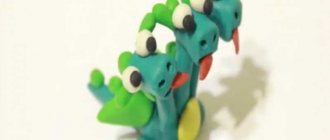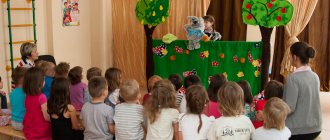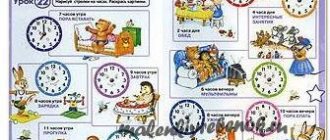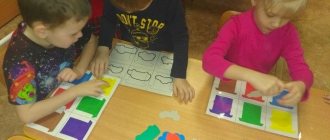Introducing numbers and numbers
Nine is the last digit in a series of single digit numbers. Acquaintance with it should occur when the previous eight have already been studied.
Before moving on to studying nine, you need to repeat and consolidate the material you have covered, solve examples on adding and subtracting single-digit numbers.
The child must know the answer to the question: what is the difference between a number and a digit and how many digits there are.
The lesson is conducted in an interactive form, using the following materials:
- educational games;
- puzzles;
- puzzles;
- Proverbs and sayings;
- simulators for the development of thinking, etc.
To make it comfortable for a child to study and easier to assimilate information, it is necessary to create an environment suitable for learning, eliminating extraneous sounds (TV, phone, tablet, etc.). You should create a working atmosphere in the room. It is not advisable to conduct a lesson in a children's room, where there are many toys and other elements that distract attention.
It is better to sit at a table in a large, bright room. During the lesson, you need to take short breaks and engage in physical activity during this time. This is due to the fact that a preschool child gets tired quickly and it will be difficult for him to sit in one position for a long time.
During the lesson, the child must master writing the number nine, learn how to perform arithmetic operations with it, concentrate attention on an object and complete tasks independently.
As educational material you can use:
- training video;
- books on mathematics for preschoolers;
- interactive maps;
- copybooks, coloring books;
- computer games.
The material should be presented in such a way as to interest the child. This is due to the fact that children cannot concentrate on what is not interesting to them. Perseverance and attentiveness must be developed gradually.
After the lesson, the child should:
- know the composition and formation of the number 9;
- be able to correlate the number of objects and objects with the number;
- be able to break a number into its components.
Searching for associations to facilitate understanding
To make it easier for a child to learn and remember nine, you need to make a series of associations with familiar objects and phenomena. Poems and pictures with the number 9 will help with this.
You should draw the child's attention to the fact that 9 looks like an inverted six.
You can also draw a parallel between nine and the letter D. Thus, the child will quickly remember not only numbers, but also letters.
Examples of what a 9 is like include:
- comma;
- elephant head with trunk;
- half a pretzel;
- a ball of thread;
- fish caught on a hook;
- seahorse;
- number 0 with a tail;
- open lock;
- ear;
- earring, etc.
Thanks to associative thinking, the memorization process is greatly facilitated.
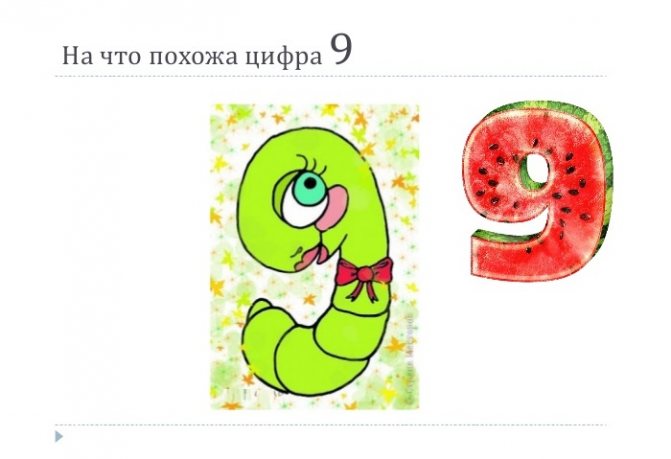
What does it look like?
An interesting question to ask your child is: what does the number 9 look like?
Probably the first answer will be “to the inverted number 6.” And then we’ll start comparing with objects and phenomena. Photos of various objects that look like a nine, puzzles where numbers are often encrypted using other words and concepts, the number 9 in pictures, etc. can be a great help with this.
There are many more different tasks where the number 9 is involved.
Riddles will help you develop your intelligence and count to 9 at the same time. It is riddles as a genre of folklore that provide rich food for the mind. Read the riddles to the children and let them guess what number they are talking about. Riddles will help start the lesson in an interesting way so that the kids get involved in the work.
Sayings, proverbs, tongue twisters, and poems will help develop speech and diction in the classroom. They will not only teach you how to count to 9, but also how to pronounce sounds correctly and construct sentences. An interesting poem by S. Marshak “Merry Counting”, where all the numbers are present, but you can only take from it an excerpt that describes the number 9. Other authors also have poems, for example, A. Barto. You can download poems about the number 9 on our website. Ask the children at home, together with their parents, to find poems about numbers. Poems will also help you start a lesson in an interesting and unexpected way if you, as a teacher, are teaching children in 1st grade.
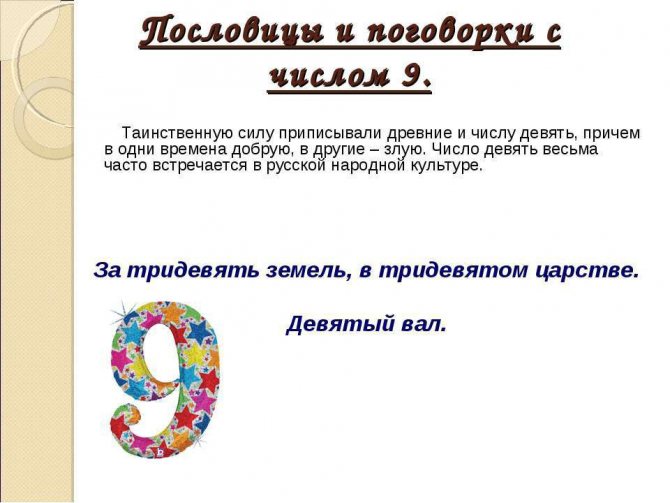
Proverbs and sayings, which are usually edifying in nature, can be used in the middle of class or as homework. It would be interesting to suggest depicting what proverbs and sayings are about in pictures. Let the kids draw at home how they understand the given proverbs and sayings. They will also have to practice writing the number 9 to depict the content of folklore works.
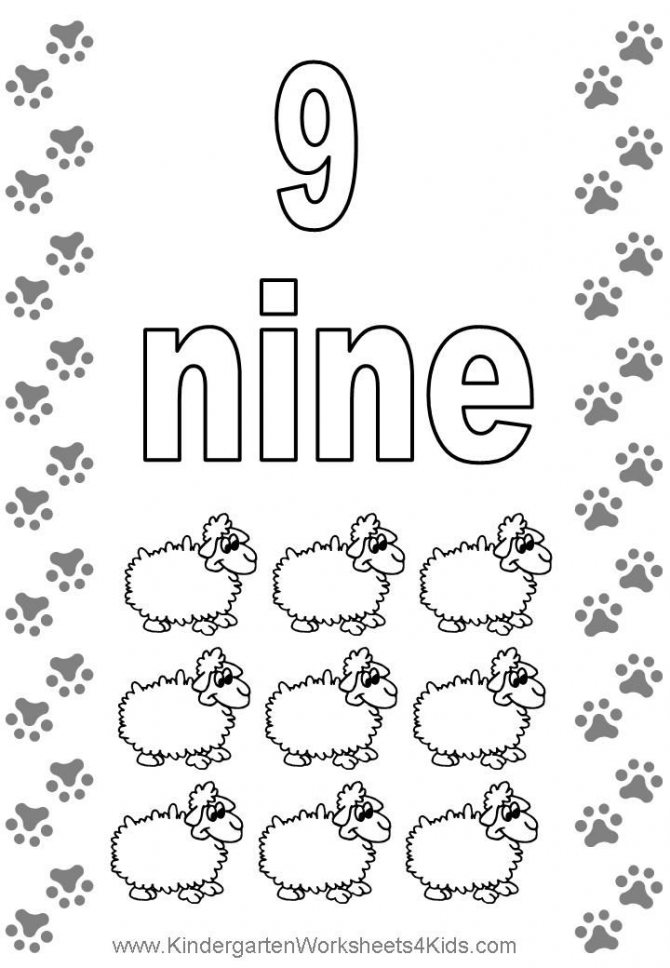
Number 9 in English.

Origami: how to fold the number 9 from paper.
Tongue twisters will help children develop speech. You can also download tongue twisters on the website. Offer them to the kids as a break between writing or other types of work.
Coloring with the number 9 will help develop fine motor skills, accuracy and creative thinking. The baby not only learns and remembers the number, but also learns to trace drawings along the contour and color without going beyond the designated lines. Coloring is an excellent preparation before a child begins to learn to write. The coloring book will also serve as homework for preschoolers or children attending 1st grade. Many teachers are inclined to believe that coloring books are no longer relevant for school: copybooks are taking their place. However, in vain: coloring can be an excellent tool for an integrated lesson in mathematics and drawing.
You can study the number 9 by offering your child puzzles. The puzzles themselves represent an encrypted word, in this case, the number 9. Solving the puzzles requires a lot of ingenuity.
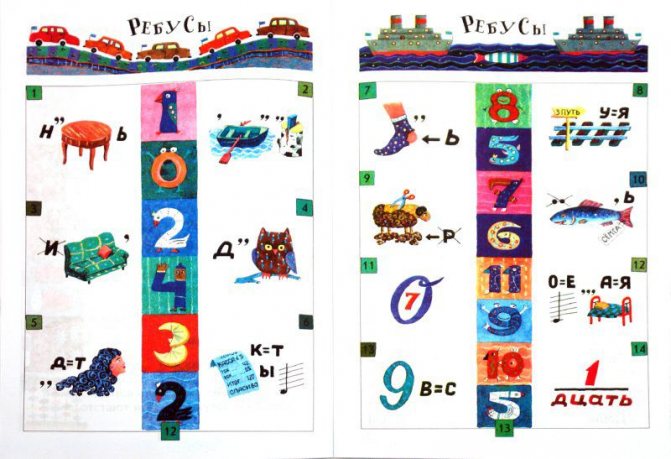
To learn how to write the number 9, your child will definitely need copybooks. Have him try circling the number before writing on his own. Then let him write on his own. Stimulate your child, praise him more often, then everything will probably work out.
Simple problems for numerals
Simple tasks for preschoolers will help them master new material:
- There were 6 puppies in the booth. Then 3 more puppies were brought there. How many puppies are there in the kennel?
- Small houses are drawn on a piece of paper. Some of them have numbers and others don't. You need to return the missing signs to the houses by writing them in the correct field.
- The following examples need to be solved: 8+1, 5+4, 6+3, 7+2.
- Sveta had 3 pencils in her box. Zhenya gave her 6 pencils. How many pencils did Sveta have in her box?
- There were 9 ripe pears hanging on the tree. Maxim picked 2, mom took 3 for the pie. How many pears are left on the tree?
- The children picked 8 red tomatoes and 1 green one from the garden. How many tomatoes did the children collect?
Poems about the number 9
***
Number nine or nine, Circus acrobat: If she stands on her head, Number six will become nine.
***
This little bandit sleeps in his mother's belly! I've been waiting for nine months, that's it! I'll go play alone!
***
Number 9 sleeps in the crib. Nine has a sweet dream. Nine stars shine in it, - There are no more wonderful ones in the world.
The number takes them in its palms, What a good dream! The stars are warming Nine, her crib is all in the rays.
***
Nine, like six, Take a closer look. Only the tail is not up, but down.
***
You can measure your height with a tape measure; you can still see the number 9 in it.
***
The number nine is not simple, like a big comma. She's friendly with frogs - she's a tadpole! This figure is simply awesome! Turning like an ace, Becoming a six, like a lock, Closes the doors at night.
***
Nine boys at the entrance -
They play together in the yard
And from the balconies to the guys
Nine grandmothers are watching.
Strengthening trainers
To consolidate the material covered, you need to practice a lot. Special simulators for improving writing skills will help with this:
- Training manual “Universal simulator. Numbers and counting." S.V. Petrenko.
- Exercise book “Write and erase! I’m learning numbers.” Published by Clever.
- Materials for children's development. Numerical simulator “Entertaining spins. We count from 1 to 10."
- Transparent copybooks “Writing numbers.” V.A. Belykh.
- Coloring simulator “Pig”. O.M. Nosova.
- Complex simulator "Mathematics". ON THE. Latysheva.
- Cards “Find and recognize numbers up to 10. Reinforcing numbers.”
- "Counting within 10. Solving exercises." Author's programs O. Lysenko.
- “Numbers and numbers. Let's learn to count." O. Zemtsova.
- "Mathematical simulator." School for preschool children.
These materials help to study oral and written arithmetic. The tasks that are given in them are suitable for children of preschool age, as well as for those who have entered 1st grade. Thus, children can take a preparatory course at home before entering school.
If a teacher or parent wants to make sure of the quality of the knowledge acquired, you can take an online test or test the child yourself.
Video sequence
A presentation in pictures and photos will help teach children to write and count to 9 correctly. The presentation can be useful if you are a teacher and are going to a lesson in 1st grade. The presentation can also be used at home. You can download it on our website. The presentation is an excellent video guide if you don’t know where to start teaching the number 9.
Thus, learning what the number 9 looks like with preschoolers or children who go to 1st grade can be fun and interesting. Use available tools for this, count, show pictures and photos, study tongue twisters and proverbs . Your child will not only master mathematics, but also receive full development.
